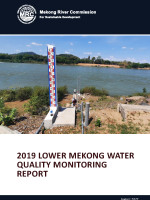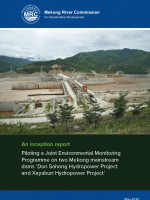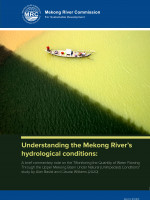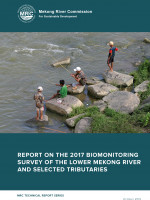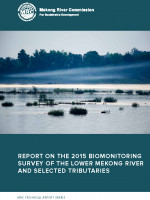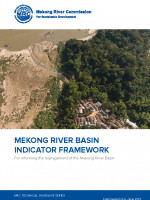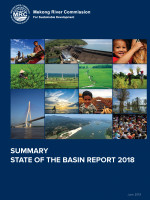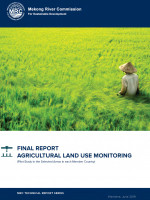Reports
2019 Lower Mekong Water Quality Monitoring Report
This report contains the assessment of the status and trends of water quality at 30 stations across the Lower Mekong Basin (LMB). In addition to the assessment of water quality at all 17 mainstream and 5 Bassac stations, this report also includes the results of water quality analyses at 8 selected tributary stations covering 7 tributaries of the Mekong River, namely the Mae Kok River, Nam Ou River, Houay Mak Hiao, Nam Mun River, Se San River, Sre Pok River, and Tonle Sap River.
Download | DOI: 10.52107/mrc.ay2l1c | Published on: 01 Jun 2020 | Language: English
An inception report on piloting a Joint Environmental Monitoring Programme on two Mekong Mainstream Dams ‘Don Sahong Hydropower Project and Xayaburi Hydropower Project’
The inception report explains how and why the piloting on the two Mekong mainstream dams (Xayaburi and Don Sahong) is being conducted. It details the types of monitoring to collect data around five disciplines: hydrology and hydraulics, sediment, water quality, aquatic ecology, and fish and fisheries.
Download | DOI: 10.52107/mrc.ajg3ub | Published on: 20 May 2020 | Language: English
Understanding the Mekong River's hydrological conditions: A brief commentary note on the "Monitoring the Quality of Water Flowing Through the Upper Mekong Basin Under Mekong Basin Under Natural (Unimpeded) Conditions" study by Alan Basist and Claude Williams (2020)
This publication discusses the Mekong River’s hydrological conditions, as it attempts to offer a brief commentary on the “Monitoring the Quantity of Water Flowing Through the Upper Mekong Basin Under Natural (Unimpeded) Conditions” study by Alan Basist and Claude Williams.
Download | DOI: 10.52107/mrc.ajg4w9 | Published on: 21 Apr 2020 | Language: English
Report on the 2017 Biomonitoring Survey of the Lower Mekong River Basin and Selected Tributaries
The report describes the biomonitoring survey conducted in the dry season of 2017 in the Lower Mekong Basin (LMB) which contributes to the evaluation of the overall ecological health of the river.
Download | DOI: 10.52107/mrc.ajg4wd | Published on: 06 Feb 2020 | Language: English
Report on the 2015 Biomonitoring Survey of the Lower Mekong River and Selected Tributaries
The report describes the biomonitoring survey conducted in 2015 in the Lower Mekong River Basin (LMB), which contributes to the evaluation of the overall ecological health of the river.
Download | DOI: 10.52107/mrc.ajg4wg | Published on: 05 Feb 2020 | Language: English
Mekong River Basin Indicator Framework
The Mekong River Basin Indicator Framework provides a consistent and streamlined approach to data collection, analysis and reporting, to help alert Member Countries to the key issues and trends and identify areas for further investigation and cooperation across five core dimensions (environment, social, economic, climate change and cooperation).
Download | DOI: 10.52107/mrc.ajg4wi | Published on: 05 Feb 2020 | Language: English
Summary State of the Basin Report 2018
The State of Basin Report (SoBR) is a flagship product and an integral part of the MRC’s strategic planning cycle. Prepared every five years, the report assesses conditions within the basin and the impacts that development and use of the water and related natural resources are having. It is a basis for the Member Countries and other key stakeholders to discuss and determine appropriate actions for ensuring sustainable development of the Mekong basin.
Download | DOI: 10.52107/mrc.ajg4wl | Published on: 05 Feb 2020 | Language: English
Final Report Agricultural Land Use Monitoring (Pilot study in the Selected Areas in each member country)
This pilot study analyses driving forces of major agricultural land-use changes and its impacts on local people’s livelihoods, and provides key recommendations on basin-wide management and development in agriculture and irrigation sector.
Download | DOI: 10.52107/mrc.ajg545 | Published on: 28 Jan 2020 | Language: English
Biomonitoring Survey of the Lower Mekong River and Selected Tributaries 2017
The report describes the biological indicator groups sampled during 2017, uses this information to derive biological indicators for the sites examined, and use biometric indicators to evaluate these sites.
Download | DOI: 10.52107/mrc.ajg4yj | Published on: 30 Oct 2019 | Language: English
